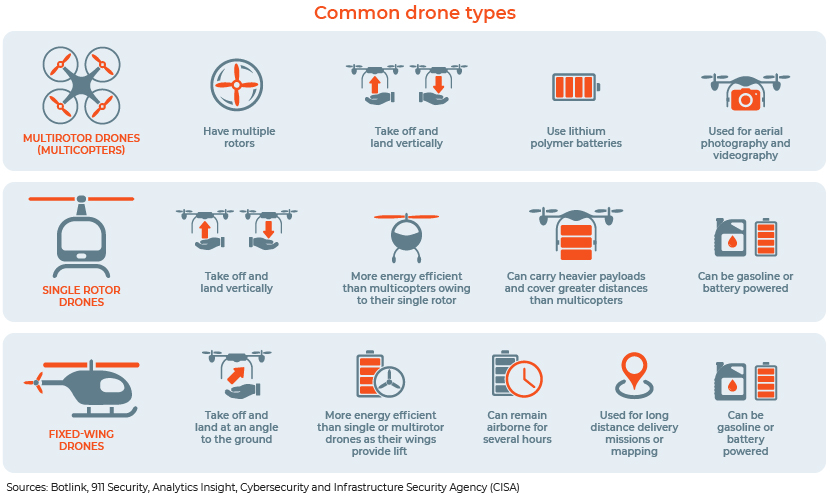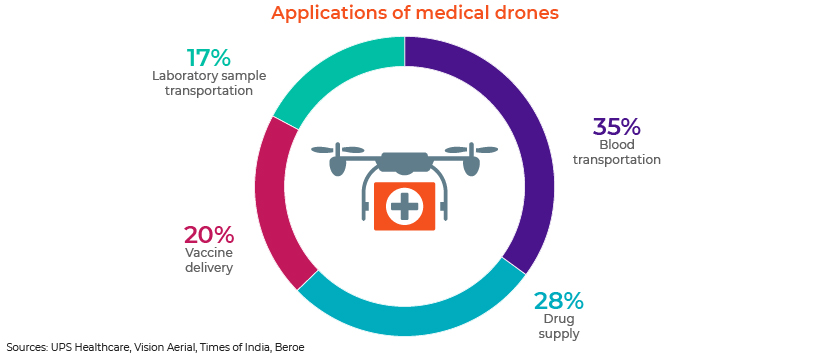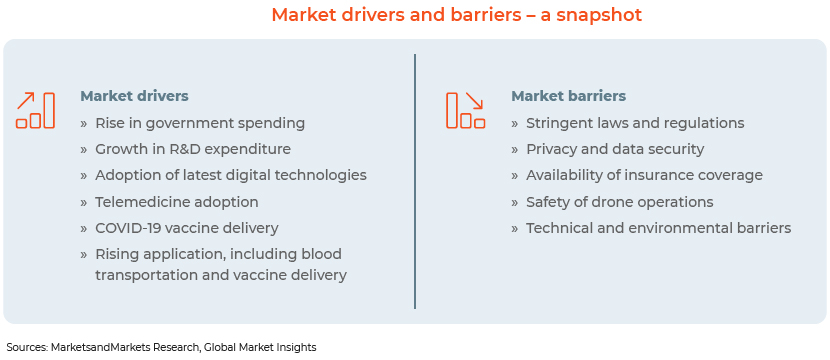The healthcare industry has been transformed by the disruptive digital technology of drones, also known as unmanned aerial vehicles (UAVs). Drone technology was introduced for the first time in Japan at the beginning of the 1980s to spray pesticides on rice fields. As the technology proved highly effective, research universities, start-ups and large enterprises began working together to develop other types of drones, leading to their widespread use across industries, including infrastructure, transport, insurance, media and entertainment, telecommunications, agriculture, security and mining.
While the applications of drone technology are vast and dynamic, this blog focuses primarily on drone technology within the healthcare industry; we look at market size, applications, drivers, trends, barriers and COVID-19 impact in the medical drones market.
Market forecast analysis
As per a Fior Markets report, the global medical drones market was valued at USD109.08m in 2019 and is forecast to grow at a double-digit CAGR of 24.8% to reach USD641.86m by 2027.

Types of medical drones
Medical drones can be broadly classified into three types:
Fixed-wing drones have rigid wings and can carry high-density payloads and data link equipment. Based on utility and size, these are further categorised as large, medium and small fixed-wing drones. They can fly at high altitudes and speeds and can cover large distances within a short span of time. On the flip side, fixed-wing drones are expensive and require large areas for landing and take-off.
Rotor drones are strong and similar in structure to a helicopter. These can be further classified as single-rotor or multirotor drones. Single-rotor drones are strong, flexible and can carry heavy payloads while multirotor drones are stable, cheap and easy to manufacture. Rotor drones can land and take off vertically, and hence require less area for landing and take-off; therefore, many industries prefer these drones over fixed-wing drones. However, the design and manufacture of rotor drones entail high mechanical and electronic complexity, which poses challenges to manufacturers.
Hybrid drones are the latest technology drones and use two or more energy sources for efficient flying. They are also fitted with artificial intelligence-based software, which makes them more advanced, fast and robust. As a result of these features, hybrid drones are gaining widespread use across a number of industries.

Applications of medical drones
-
Blood and laboratory samples transportation: The transportation of blood and laboratory samples needs appropriate temperature balance and safety. Medical drones have been fulfilling the need for the safe, fast and efficient transportation of medical supplies even to remote areas. As laboratory samples are light in weight, drones can easily carry these. In conjunction with WakeMed, UPS was the first company to use drones for medical supplies, in North Carolina
-
Vaccine delivery: Amid the COVID-19 pandemic, the use of medical drones saw a phenomenal increase for vaccine deliveries. The recent launch of the Medicines from the Sky project in Telangana, India, for the delivery of vaccines and drugs using medical drones has paved the way for the efficient delivery of medical supplies to far flung regions in the country
-
Organ transfer: Leading drone manufacturing companies are testing the utility of medical drones to transfer organs from one place to another. The critical and time-sensitive nature of organ transfers (4-36 hours to move organs from donor to the patient) makes ultra-fast transportation a prerequisite, and drones have the ability to conduct fast, safe and cost effective delivery
-
Small medical devices transport: Drones can be used to transport small medical devices, such as automated external defibrillators, to accident or disaster sites that have urgent requirement for medical devices. This can make it easier for medical personnel to provide emergency treatment
-
Search and rescue (SAR): SAR drones are emerging as powerful tools for public safety and security teams, as they have several advantages over manual modes of search, including their low cost, payload versatility and quick deployment. Drones can also enable enhanced situational awareness. In addition, they are safer and more adaptable than manned aircraft and provide a bird’s eye view of the search area with enhanced coverage and excellent image resolution. For instance, the Vision Aerial SAR1 System helps in the quick identification of victims using thermal and infrared cameras and can cover a wide area within a short span of time
-
Telemedicine drone: Telemedicine and telecommunication have seen rapid advancement amid the COVID-19 pandemic, with virtual platforms being used in remote diagnosis and treatment of patients. Telemedicine drones can be used to establish wireless communication between a surgeon and a robot to perform telesurgery. Such drones are also used to deliver medical supplies and other packages in emergency clinical scenarios to provide quick patient care

Market drivers and trends
-
Transportation and logistics: The rising application of medical drones for the transportation of blood, vaccines, laboratory samples and other medical supplies will have a positive impact on the overall growth of the global medical drones market. For instance, Zipline, a US-based company collaborated with Walmart (NYSE:WMT) for the delivery of health and wellness products using drones in September 2020
-
Rising government initiatives: Increasing government expenditure on drone manufacturing, in line with the rising focus of government bodies on healthcare digitisation, will enhance industry growth. The Ghana government, for instance, recently signed an agreement with a US firm for the transportation of medical supplies to hospitals and clinics using drones, strengthening healthcare supply chains in the country
-
Rising adoption of latest technologies: Rapid advancements in medical drone technology will make it possible to efficiently deliver essential medical supplies with short half-lives. In April 2019, Zipline launched the largest vaccine drone delivery network in Ghana, enabling the quick and smooth delivery of medical facilities to remote and distant areas. Leading companies, such as Amazon (NASDAQ:AMZN) and Google (NASDAQ:GOOGL) also have plans to launch drones that are faster and more efficient and safe
Barriers
-
Technical and environmental barriers: Several factors constrain the growth of the medical drones market, including vibration during transport and concerns about movement precision, battery life and maintenance of continuous communication between ground pilot and the drone. In addition, environmental barriers include humidity and rapid changes in air pressure and temperature during the delivery of blood samples, vaccines, drugs and other medical supplies
-
Stringent laws and regulations: Strict legal restrictions pose a threat to the growth of the medical drones market at a global level. In addition, the regulatory scenarios of different countries can vary. Drone manufacturing companies would need to be cognisant of these laws before launching their products in a country

Impact of COVID-19 on medical drones market
Over the past two years, leading manufacturing companies, healthcare start-ups and corporates have been exploring new areas for expansion within the drone market. The medical drones market has seen positive impact from the COVID-19 pandemic, with the drones being used for the following applications.
1. Surveillance and delivery: Surveillance of isolated virus-infected areas and the supply of drugs, vaccines, blood and other medical devices to such regions
2. Disinfection: Aerial spraying of public areas to disinfect potentially contaminated places
3. Monitoring: Public space monitoring and guidance during lockdown and quarantine
Conclusion
The future of the medical drones market appears promising, particularly the next five to six years. Drone manufacturing companies are expected to adopt go-to-market strategies, M&A and new product launches to stay competitive and meet the rising demand for medical drones across the globe. During the COVID-19 pandemic, we saw drone technology being adapted to serve the needs of consumers, manufacturers and patients. Continued development in its technology should further strengthen the use of drones not only in the healthcare industry but also across other sectors, including e-commerce, mining, chemicals, forest conservation, construction, geography mapping, filmmaking, petrochemicals (oil and gas) and public safety (law enforcement, fire departments, search and rescue operations).
